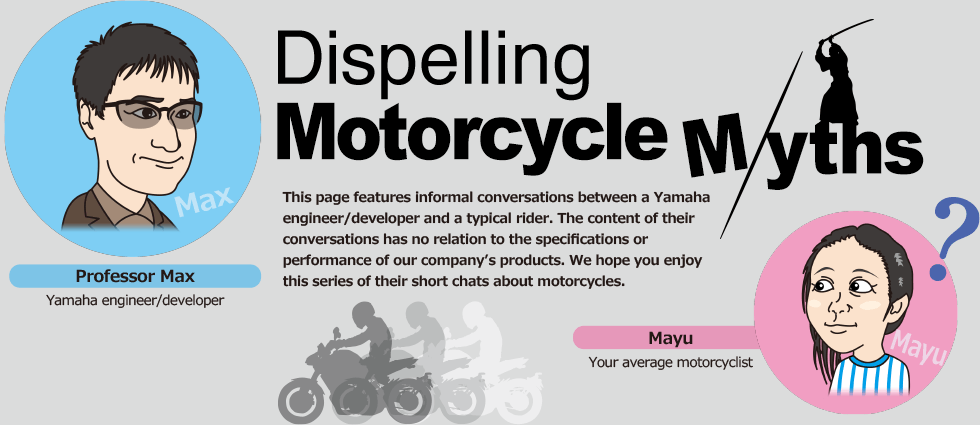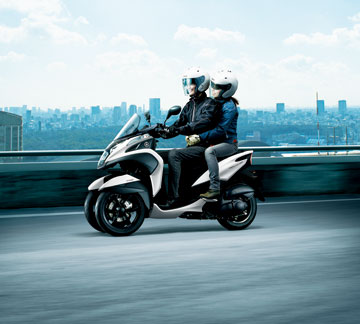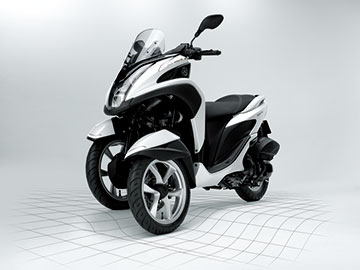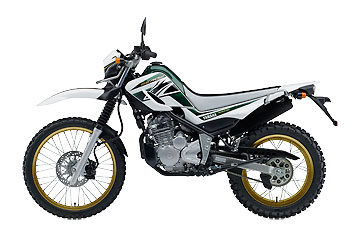Dispelling Motorcycle Myths
Introducing the stories behind Yamaha Motor's technologies.
Vol. 1 “They say you shift your body weight to make a motorcycle turn...”
I started riding motorcycles 17 years ago and what I liked about them was definitely the fun of cornering. But I only feel like I really rode well through a corner every now and then. I honestly don’t really understand the basics, like why a motorcycle turns or what the secret is to skillful cornering.
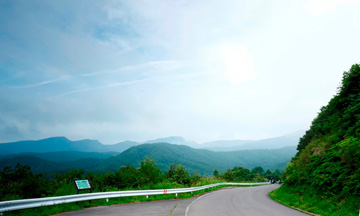
Cornering is what makes motorcycles so fun to ride.
Hmm, well Mayu, how do you make the bike turn? Do you have your own way of going through a corner? And why do you suppose a motorcycle leans when it turns?
Well, I look ahead towards the exit of the corner and put my weight on the inside footpeg (#1).
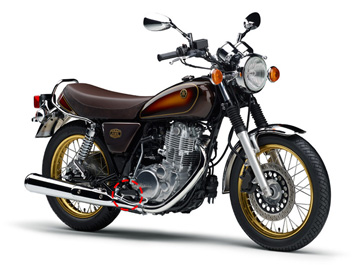
(#1) Putting pressure on the footpegs is sometimes a way to aid in starting a turn.
Right. When going through the slalom course at a riding school, they teach you to put your weight on the footpegs to help get the bike to turn. But Mayu, when you’re riding on the road do you do this every single time you turn? It’s not like I never put my weight on the footpegs when cornering, but when I’m out touring I almost never do. After all, the footpegs are where you rest your feet when you’re on the bike, right?
Really? So I guess it’s more important when you really want to lean the bike way over. And shifting your body weight into the turn too is key, I think. MotoGP riders move their body weight so far over to the inside of a corner that their knees and sometimes their elbows scrape the track. So to make the bike lean you have to move your weight, right?
Yes, racers in MotoGP and other top series typically use a dramatic hang-off style on their bikes (#2). But hanging off isn’t a “requirement” for making a bike lean in order to corner. I see it simply as one way they use their bodies to balance out the centrifugal force at work. After all, motocross riders often lean outward when cornering and that puts their body weight in the opposite direction of the turn (#3). In other words, where the rider’s weight is shifted isn’t the same direction as where the bike is being leaned.
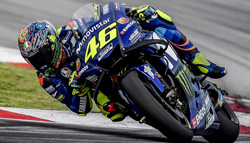
(#2) The “hang off” style of riding prevalent in MotoGP
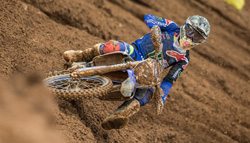
(#3) Motocross riders lean their body weight in the opposite direction of the turn.
So both MotoGP riders and motocross riders move their body weight to maintain balance when cornering. Does that mean there’s a relationship between moving your body weight and leaning the bike while turning?
I have an idea. Watch this video. It shows one of Yamaha’s R&D projects where a robot rides a motorcycle around a racetrack. As you can see, the robot doesn’t move its weight around at all. It can’t! Nevertheless, it still rides the bike through corners smoothly and at high speed.

Yes, but they’re using electronics to control the bike and the robot, right? It also feels a little weird to see a robot riding a motorcycle designed for humans.
Anyway, how is MOTOBOT making the bike lean into the corners without moving its body weight? Is he moving the handlebars? Is he pushing the bars in the opposite direction for a split-second?
“Pushing the bars in the opposite direction for a split-second” is one way to put it. That’s called “countersteering.” (#4) For example, when you want to go left, you push the left handlebar to turn the handlebars to the right for just an instant, but then the bike leans to the left: the opposite direction. I think everyone has experienced this and in fact, that’s the key.
When a rider corners on a bike, they’re using countersteering, whether they’re aware of it or not. Even though the steering angle is extremely small, the rider is actually pushing the handlebar in the opposite direction of the turn.

(#4) Countersteering: Pushing lightly on the left handlebar moves the handlebars to the right for an instant and causes the bike to lean in the opposite direction.
Oh, so you push the handlebar in the direction you want to go and bike leans and turns that way.
That’s right. If you want to turn left you slightly push on the left handlebar to move the handlebars to the right and then the bike leans left. That’s countersteering.
Here’s another example: imagine you’re balancing an umbrella in the palm of your hand. If you want to move it left, you have to momentarily move your palm to the right so the umbrella will start to fall to the left. Then you move your hand to the left to keep the umbrella balanced (#5). Cornering on a motorcycle is very similar.
Basically, a rider uses countersteering to cause the bike to lean over in the direction of the corner. Once a certain lean angle is reached, the rider unconsciously stops countersteering and by releasing the strength in his or her arms, the bike will naturally keep the handlebars turned in the direction of the corner.
When this happens, the bike is leaned over, but is balanced and corners smoothly and naturally. Most riders perform these actions automatically and without conscious effort. And since the handlebar angles involved with countersteering are incredibly small, from less than 1° to 2° or so, most riders don’t feel anything at the handlebars when they’re doing it.

(#5) The motions made when countersteering are similar to those made when balancing an umbrella in the palm of your hand.
I see, so that’s how countersteering works.
MotoGP riders turn their handlebars in various different ways when cornering; sometimes they turn the bars a lot, sometimes very little. Some of these are likely techniques only used by the best riders in the world. You might find it interesting to watch some of the bikes’ onboard footage from a MotoGP race and observe how the riders manipulate the handlebars when cornering.
I see, thanks for explaining everything! So riders really do have to use the handlebars to make the bike lean and turn. But now I wonder, how can people do such a complex thing without even thinking about it?
Human beings evolved over thousands of years in the Earth’s gravity, so the ability to skillfully balance gravitational forces probably comes to us naturally.
“You shift your weight to make motorcycles turn” is probably just another motorcycling myth.
Vol. 2 “They say that when you accelerate, the rear of the bike squats...”
For me, the feeling of acceleration you get with a motorcycle is what makes riding them so much fun. It’s exhilarating to feel the acceleration directly with your body, especially when it’s from a stop or opening the throttle and you feel the rear of the bike squat down and the rear tire grip the pavement. It’s a sensation that makes you fall in love with bikes!
I agree! But I noticed you said that the rear of the bike “squats down.” It certainly feels like that when you accelerate, and when you watch cars around town you can see the rear of the vehicle sink down as it accelerates. But do motorcycles actually do the same thing? Let me show you a video (#1).

(#1) Does the chassis actually squat?
What do you think?
Hmm…. In this video the rear isn’t squatting. It actually looks like it’s moving upwards? But when you ride it feels like it’s compressing.
It feels that way because of the movement of the front fork. When you accelerate, the front fork extends, which brings the front of the chassis up and the rear down in response. So it gives the illusion that the rear of the bike is compressing.
Oh, so if the front fork is soft, does that increase the feeling of acceleration? That seems kind of strange.
Well, if the front fork doesn’t move, the feeling of acceleration you get may change. On a typical bicycle, the fork has no damping mechanism so there’s no change in its chassis’ stance. But because a motorcycle changes its stance, you feel the acceleration more.
The performance of the motorcycle also influences the way its stance changes, and the secret to that lies in the swingarm. Its shape, length, positioning, rigidity and more all make a big difference.
Yeah, swingarms do look very sturdy and strong. But I don’t really understand what it does. It connects the rear wheel to the shock absorber, right?
Yes, but it also performs other important tasks. Engine power is what turns the rear wheel and the friction created between the tire and the road is what propels the bike forward. In simple terms, the power is transmitted from the engine to the front sprocket, then to the chain, then to the rear sprocket, then the wheel and tire, and finally to the road surface (#2).
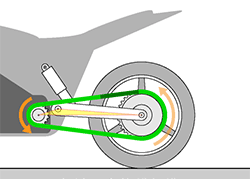
(#2) The flow of power with a motorcycle
When that happens, the chain is pulled with tremendous force and the swingarm bears that force. However, what’s key is how the swingarm bears that force.
How the swingarm bears the force? I don’t understand what you mean by that, but it must be in the forward direction, right?
Correct. But the force is not transmitted in a strictly horizontal direction. If you drew a line connecting the front and rear drive sprocket shafts, the swingarm’s pivot point is located slightly above it on most bikes (#3).
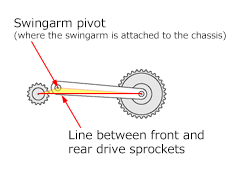
(#3) Relationship between a motorcycle’s sprockets and swingarm
Even if it were located below that line, the bike would still move forward, but there’s a good reason why it’s mounted above it. Let’s compare what happens when it’s mounted above and below (#4, #5).
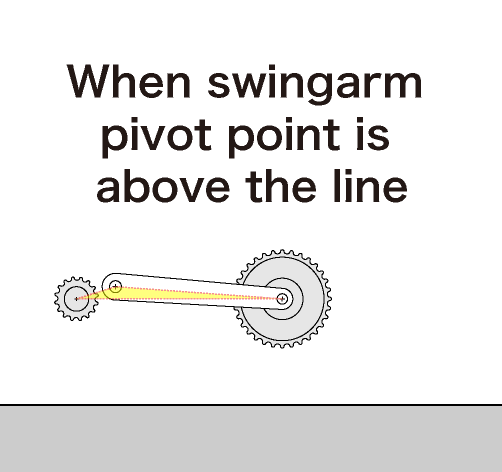
(#4) Pivot point above
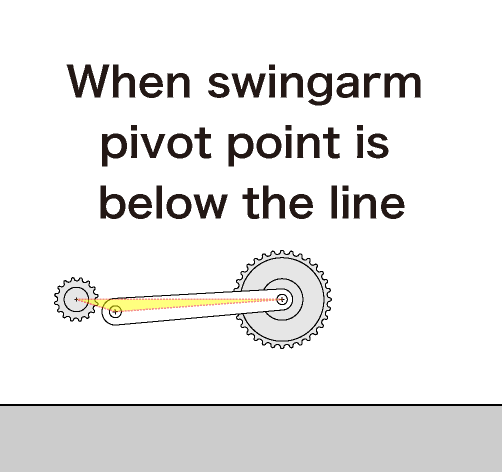
(#5) Pivot point below
Wow, that’s interesting.
Imagine how the triangle will change its shape.
The triangle changes? Where is the triangle?
The triangle is formed by the line between the front and rear drive sprockets and the swingarm pivot point on the chassis. This diagram explains it (#6).

(#6) Triangle formed between the sprockets and swingarm pivot
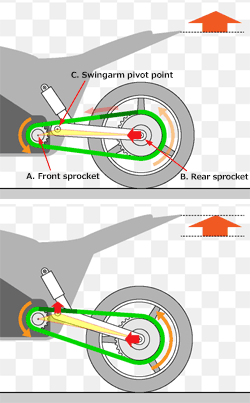
(#6) Triangle formed between the sprockets and swingarm pivot
During acceleration, the engine’s torque (force) pulls the drive chain and tries to pull the rear wheel towards the engine. That’s what’s happening in the left diagram. This force tries to shorten the length between A and B. However, the distances between A and C and B and C are fixed and do not change. As a result, C, the top point of the triangle, rises as you can see in the right diagram. Because the tire is in contact with the road surface, only the front of the swingarm rises, and keeps rising.
I see.
When the swingarm pivot rises, the rear of the chassis doesn’t sink, but rises. Of course, how much it rises depends on the swingarm angle.
So, the feeling of the rear of the bike squatting under acceleration is really just an illusion while in reality, the rear of the bike rises when you accelerate.
That’s right. The pivot point and the shape and length of the swingarm have a big influence on the bike’s handling. With GP racebikes from the 1990s like the YZR500 and even the YZR-M1 MotoGP machine, the swingarm pivot is adjustable (#7).

(#7) YZR-M1 swingarm pivot
When you think about how these detail technical aspects are at work, it makes races even more interesting to watch.
Thank you! But when I watch the start of a MotoGP race, it still looks like the rear of the bikes are squatting.
MotoGP bikes accelerate so hard that the front wheel sometimes comes off the ground. These wheelies just make it look like the rear of the bike is squatting (#8).
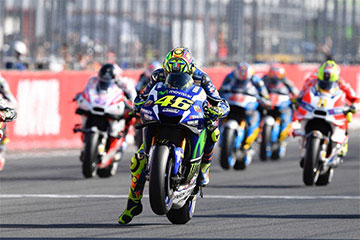
(#8) Grand Prix of Japan in 2016
“The rear of the motorcycle squats under acceleration” is probably just another motorcycling myth.
Vol. 3: “Do Leaning Multi-Wheelers (LMW) get flats a lot because they have more tires?”
Mayu, have you ever ridden the Tricity before?
Right? There are a lot of plusses with the LMW platform, but the feeling of stability and front-end confidence you get is definitely the biggest draw.
They don’t feel unstable. That unique, almost mystical feeling of stability you get with them is probably irresistible for some riders.
There are a lot of people at Yamaha that ride them to work. When crossing the bridge over the Tenryu River, there’s often a strong dry wind blowing and many riders say the Tricity feels as stable as a much bigger bike in a crosswind.
So, an LMW feels stable in crosswinds because it has two front wheels. But some people say that because it has more tires, it also gets more flats.
Well, that’s interesting. I didn’t know that sort of talk was going around.
The other day my friend’s bike got a flat rear tire from a nail. He took it to a shop right away to get it fixed and heard some customers chatting about LMWs being susceptible to punctures.
I see. But just because the Tricity has three tires doesn’t mean it has a higher chance of getting a flat than any other motorcycle.
Actually, the chances of getting a flat can be less with an LMW. Most punctures caused by nails are said to happen when the front tire rolls over a nail lying on the road and tips it up, so it punctures the rear tire which is rolling right behind the front.
Wow, I never thought that my bike’s front tire would actually be the reason the rear tire would go flat...
Of course, the bike’s speed, wheelbase, how the nail is positioned and a bunch of other factors all have to be a certain way for this scenario to occur, so just because you ran over a nail doesn’t necessarily mean you’re going to get a flat tire.
I see. I kind of felt that I usually end up with the rear getting flats more often, so that makes sense.
Punctures caused by nails and other foreign objects while riding are said to occur most often to the rear tire. But if that’s the case, because the LMW’s rear wheel is not directly behind the front wheels, it therefore should be less likely to be punctured by nails run over by either front wheel. Here’s a simple animation that illustrates this.
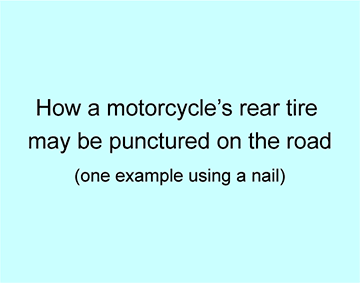
That makes it easier to understand.
So that’s why the rear tire is tubeless! I thought it was to save weight.
Of course, avoiding punctures isn’t the only reason and the tubeless tire is indeed lighter. But the real advantage of a tubeless tire is when it gets punctured, it doesn’t lose air pressure so quickly.
Well, I just learned something new!
In any case, compared to two-wheeled motorcycles, there’s definitely less chance of getting a flat rear tire with an LMW.
Still, that doesn’t mean LMWs never get a flat tire. I've heard that if you pull the nail out, the tire deflates very quickly, so it’s best to stop the bike immediately and leave the nail in, and go to the shop to get it fixed. Is that true?
Right, that’s the best thing to do. But either way, just because an LMW has more tires doesn’t mean it gets more punctures. That’s probably just another motorcycling myth.
Vol. 4: “Is it true that more torque means quicker acceleration?”
Professor Max, can you teach me about horsepower and torque this time? I get that horsepower is basically “power,” but it’s hard to find a different word for torque, so I don’t have a clear idea of what it is. I often hear that torque gives better acceleration, but I still don’t really get how that works.
A good topic! Do you know that both are “forces?”
Well, I read on the internet that torque shows the engine’s rotational energy or rotational force, but I don’t really understand it. How would you explain it?
Calling torque a twisting force might make it easier to understand.
A twisting force? Do you mean like how you twist a wet cloth or towel to get the water out?
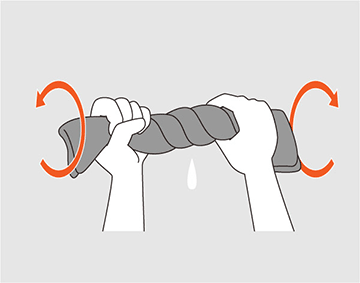
(#1) Torque can be likened to twisting a cloth.
Yes, that’s a good example. You could think of torque as the force generated when twisting a towel (#1). And when the twisting force causes an object to rotate around an axis, that rotational force can be understood as “horsepower.” With a motorcycle for example, the rotational force generated by the engine drives the rear wheel and tire, and the propels the bike forward. By the way, this only applies to engines that create rotational force.
What do you mean by “engines that create rotational force?”
Well, you could say that motorcycle and car engines are basically devices that rotate to produce drive force. They power things through rotation.
Hmm... So, are there engines that don’t rotate?
Sure. Jet engines don’t produce rotational force, so the concept of torque doesn’t apply to them (#2).
So even though they accelerate rapidly during takeoff and you can really feel it, you can’t say they produce torque?
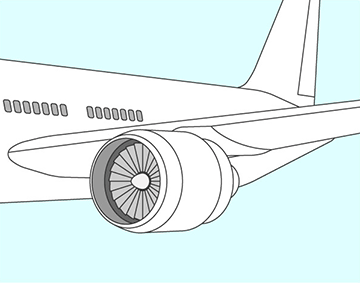
(#2) The concept of torque doesn’t apply to jet engines.
A jet engine’s performance is expressed with terms like “thrust” and “maximum takeoff weight,” not torque. But anyway, let’s return to motorcycles.
Okay. I’m starting to understand that torque is a twisting force. But what about when I hear riders say that engines with lots of torque have great acceleration?
Hmm, it sounds to me like the terms are being mixed up or confused.
I read an internet article written by an engine developer that said a small 50cc scooter engine can be made to put out as much power as the engine for a big bike. This has gotten me all confused.
Sounds like they have it backwards, right? “It’s fast because it’s got torque,” and, “Even if it doesn’t have much torque, we can make it fast.” Let’s try and clear up your confusion.
Let’s look at torque first. Imagine a Kid A weighing 30 kg and a Person B weighing 60 kg are standing on a seesaw. If Kid A is 4 meters from the pivot point and Person B is 2 meters from the pivot point, the seesaw won’t move because it’s balanced (#3).
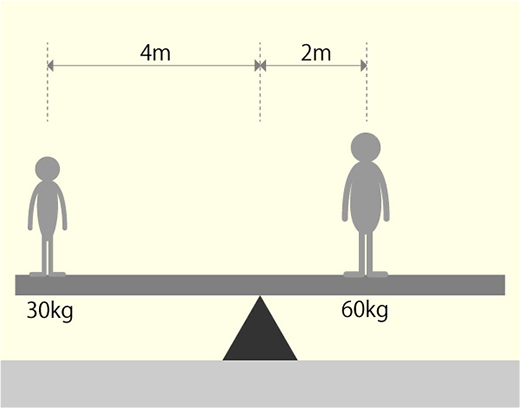
(#3) The force acting on each side of the seesaw’s pivot point is torque.
I think we learned this in elementary or junior high school, but what does that have to do with torque?
The force acting on the left and right sides of the pivot point of the seesaw is torque. There is rotational force being generated around the pivot point, but since the left and right forces are equal, the seesaw doesn’t move. In this example, the amount of torque is 120 kg∙m on each side (30 kg x 4 m = 60 kg x 2 m).
I’m starting to understand what torque is. But can you explain how it can be true that a 50cc scooter engine with little torque can put out as much drive force as a big bike’s engine?
Okay, well instead, imagine a cat and a gorilla are now sitting on the seesaw. The 5 kg cat is sitting 50 meters away from the pivot point at the edge of the seesaw. So 5 kg × 50 m means our kitty is generating 250 kg∙m of torque. If the gorilla weighs 200 kg and sits just 1 meter from the pivot, that’s 1 m × 200 kg, or 200 kg∙m of torque. So the gorilla ends up being “lighter” than the cat (#4).
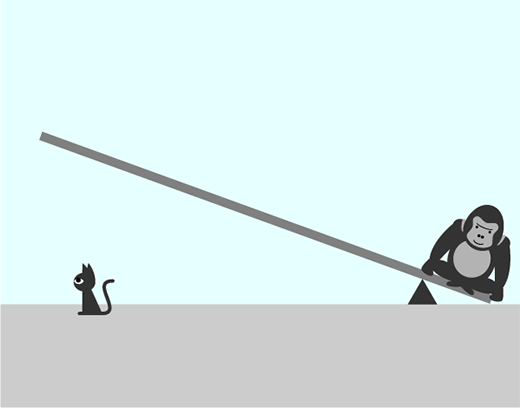
(#4) The cat beats the gorilla since torque is the force rotating the seesaw at its pivot point.
I see! The lightweight cat is the 50cc scooter engine, and since it’s so far away from the pivot point, you could say it has a “larger gear ratio.” The gorilla is like a liter bike engine and with its much smaller gear ratio being so close to the pivot point, the cat actually produces more torque!
Now you’re getting it! The length of the seesaw basically corresponds to the size of the rear drive sprocket, kind of like this (#5):

(#5) If you fit a small-displacement bike with a very large rear sprocket (left) and a big bike with a very small rear sprocket (right), the amount of torque produced at their rear wheels can be made the same.
If we go a step further, even by just changing the tire diameter, a small-displacement scooter engine can produce drive torque equal to a liter bike.
So in addition to the engine’s power, the gear ratio and tire diameter change the amount of torque generated at the rear wheel.
But a liter bike is still going to be so much faster, right? Wait, what about horsepower?
Good question. If we return to our first seesaw example, because the torque values on the left and right are the same, the seesaw is balanced and doesn’t move. Although torque is being generated, the seesaw is in a state of rest so no horsepower is being generated. In other words, horsepower is zero.
So there’s torque, but no horsepower? Now I’m not sure I understand what horsepower is...
Again, torque is simply a twisting force. And when motion generates work or speed in a given direction, the amount of power needed to move an object, like a motorcycle, is “horsepower.”
But in brochures and stuff, they have graphs of “engine performance” with lines showing how torque and horsepower change based on engine rpm (#6).
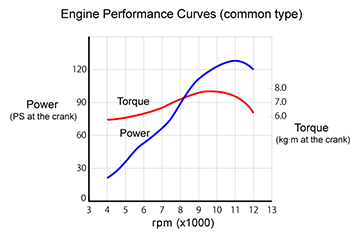
(#6) This engine performance graph shows the torque and horsepower curves separately, but condenses it all onto one graph.
Those are showing the curves for both torque and horsepower on one graph instead of showing them separately as they should be, simply for convenience. Since they’ve become common, I think in a sense they’ve actually made it easier to misunderstand what torque is.
So what kind of graph is good then?
Changing the way horsepower is shown might be easier to understand. With this kind of graph, the line for torque stays the same and horsepower is instead expressed by the area underneath it (#7).
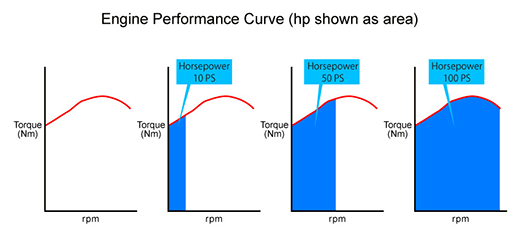
(#7) Horsepower can be easier to understand when expressed using area instead of a line (graph is for visualization purposes only).
So in other words, an engine’s horsepower is determined by its torque and rpm!
That’s right. It’s not incorrect per se that high horsepower makes a bike fast, but now you know that it’s not torque alone that makes a bike fast.
Let me give you some info about horsepower now. We define 1 horsepower as the force required to lift 75 kg by 1 meter per second. So if you can lift the same weight in just half a second, that would be 2 horsepower (#8).
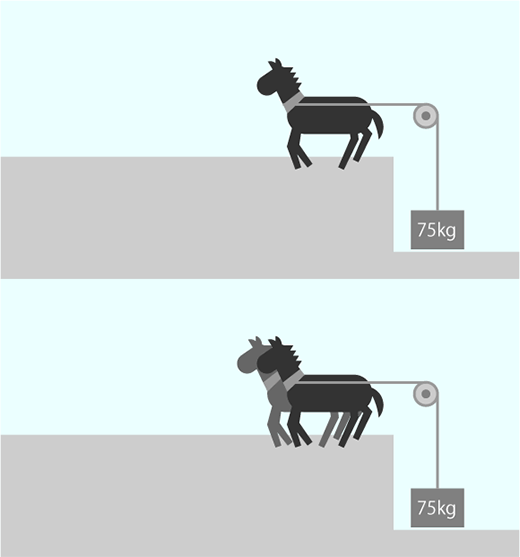
(#8) A force of 1 horsepower is required to lift 75 kg by 1 m in 1 second.
Ah, so high horsepower really does lead to a faster bike.
In simple terms, an engine with more horsepower will have better acceleration and a higher top speed. And because torque and rpm are what determine horsepower, if there’s torque but no rise in rpm, no horsepower will be generated.
I get it now. So it’s not really true that engines with lots of torque always have quicker acceleration.
Yes, that’s probably just another motorcycling myth.
